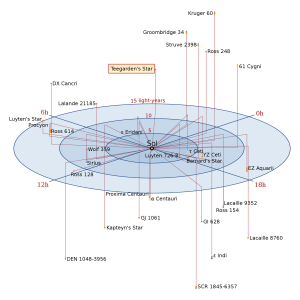This illustration depicts all of the star systems that are less than 15 light-years from Earth. The neighbors include Teegarden's Star (highlighted, above center), which is 12 light-years away. It is orbited by two planets that are similar to Earth, both of which are in the star's habitable zone, which is the region where conditions are most comfortable for life. [Inductiveload/Wikipedia]
You are here
Double Earths?
Astronomers have discovered thousands of planets in other star systems. So far, though, only a few can possibly be described as “Earth-like.” And two of those are in the same star system.
Teegarden’s Star is a close neighbor — just 12 light-years away. But it’s so small and faint that it was discovered only a couple of decades ago. It’s a fraction the size and mass of the Sun, and less than a thousandth as bright.
Its two known planets are cataloged as objects “b” and “c” in the system. Both planets are just a few percent bigger and heavier than Earth. And both of them appear to lie in the “habitable zone” — the region where temperatures are just right for life. Since the star is so feeble, that zone is quite close — just a few million miles out.
A study a couple of years ago said that both planets could have comfortable atmospheres and liquid water. But a study last year said otherwise. It found that gravitational interactions between the planets and the star could have caused problems. They could have turned b into something like Venus, with a hot, thick atmosphere. And c could have been turned into a world of volcanoes — making both planets unfit for life as we know it.
Teegarden’s Star is in Aries, the ram, which is high in the southern sky on January evenings. The star is much too faint to see without a telescope. But its location is easy to spot tonight — just above the Moon.
More about extraterrestrial life tomorrow.
Script by Damond Benningfield
Get Premium Audio
Listen to today's episode of StarDate on the web the same day it airs in high-quality streaming audio without any extra ads or announcements. Choose a $8 one-month pass, or listen every day for a year for just $30.




